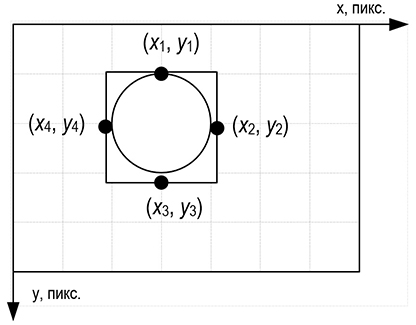
Interactive Image Processing for Robust Geometric Primitives Recognition
https://doi.org/10.31854/1813-324X-2025-11-2-41-48
EDN: SCTROE
Abstract
Relevance. Recognition of geometric primitives is used in image processing to solve problems related to the development of machine learning algorithms, reducing the analysis area and reducing computational complexity. One of the problems of primitives recognition is the resulting dependence from such external factors as: a wide range of changes in brightness, contrast and the interference caused by uneven lighting, foreign objects or pollution. A separate task is the geometric position estimation of the primitive in the image, which is defined by offsets, rotation and scale or parameters of a more complex mathematical transformation model. A wide class of tasks is not limited by the requirement of automatic processing in real time. Therefore, these problems can be solved by an interactive parameters setting. The interactive processing method ensures robustness to spatial-luminance distortions and various interferences.
The article purpose is to improve the quality of recognition of geometric primitives (using the example of a circle) in images through interactive (visually controlled by the operator) processing.
The proposed solution essence is two processing stages: the stage of pre-processing in interactive mode and the stage of estimating the geometric parameters of the primitive with automatic removal of impulse noise. At the first stage, a threshold is selected for detecting the contour of a primitive and limiting the analysis area (selecting a fragment) in the image. These parameters are determined by a graphical interface in interactive mode (for example, changing the detection threshold almost instantly displays recognized contours in the image). At the second stage, in accordance with the shape of the primitive, an area of interest is selected, which removes impulse noise (contour points that do not belong to the primitive), and the parameters of the primitive are estimated based on the point of the area of interest using the least squares method. The developed algorithm has an implementation as a program with a graphical interface. Experiments to test the developed algorithm showed satisfactory recognition of the geometric primitive “circle” on various types of images containing a road sign, a polymer gel particle, and an ferrule end face. The scientific novelty of the solution lies in the possibility of recognizing primitives, which is robust to spatial-brightness transformations (scale, displacements, brightness unevenness, etc.) and other noise.
The theoretical significance lies in expanding the capabilities of recognition methods (in particular, primitives such as “circles”) through interactive selection of parameters at the preprocessing stage.
The practical significance lies in the simplicity of image processing algorithms that are used to solve applied problems (preparing machine learning data, processing by optical micrometry methods) that do not require real-time recognition.
About the Author
A. A. DiyazitdinovaRussian Federation
References
1. Shulga T.E., Solopekin D.A. Recognition of Russian-style road signs using neural networks. Vestnik of Astrakhan State Technical University. Series: Management, Computer Science and Informatics. 2024;2:85–94. (in Russ.) DOI:10.24143/2072-9502-2024-2-85-94. EDN:LTLMXA
2. Rajesh R., Rajeev K., Suchithra K., Lekhesh V.P., Gopakumar V., Ragesh N.K. Coherence vector of Oriented Gradients for traffic sign recognition using Neural Networks. Proceedings of the International Joint Conference on Neural Networks, 31 July ‒ 05 August 2011, San Jose, USA. IEEE; 2011. p.907–910. DOI:10.1109/IJCNN.2011.6033318. EDN:PKQGGB
3. Atavullaeva Sh., Ferapontov N., Trobov Kh., Tursunova G., Djuraeva R. Determination of the composition of solutions of electrolyte mixtures by optical pyrometry. Universum: Chemistry and Biology. 2024;11-2(125):46‒51 (in Russ.) DOI:10.32743/UniChem.2024.125.11.18355. EDN:HYSJJG
4. Tokmachev M.G. A method for estimating the polymer gel granule volume by an optical technique. Computer Optics. 2023;47(6):968–971. (in Russ.) DOI:10.18287/2412-6179-CO-1271. EDN:OJTKGA
5. Bourdine A.V., Pashin S.S., Zaitseva E.S., Vasilets A.A., Antonov S.A. Fast and simple method for estimation of the in-sertion loss at the connection of singlemode optical fibers with contaminated ferrule end faces. Proceedings of the XVIIth International Scientific and Technical Conference "Optical Technologies for Telecommunications", 19–21 November 2019, Kazan, Russian Federation, vol.11516. SPIE; 2020. P. 115161O. DOI:10.1117/12.2566456. EDN:GGNEOJ
6. Pashin S.S. Research potential possibilities of estimating the basic mode transmission coefficient based on analysis overlapping of the radial distribution fields in discrete representation. Infocommunication Technologies. 2021;19(2):172–178. (in Russ.) DOI:10.18469/ikt.2021.19.2.05. EDN:QIKRUK
7. Canny J. A Computational Approach to Edge Detection. IEEE Transactions on Pattern Analysis and Machine Intelligence. 1986:PAMI-8(6):679–698. DOI:10.1109/TPAMI.1986.4767851
8. Chochia P.A. Image segmentation via contour tracking in application to the analysis of the photographs of electronic microcircuits. Journal of Communications Technology and Electronics. 2010;55(12):1466–1473. DOI:10.1134/S1064226910120193
9. Boykov Y., Jolly M.-P. Interactive Organ Segmentation Using Graph Cuts. Proceedings of the 3rd International Conference on Medical Image Computing and Computer-Assisted Intervention, MICCAI 2000, 11‒14 October 2000, Pittsburgh, USA. Lecture Notes in Computer Science, vol.1935. Berlin, Heidelberg: Springer, 2000. p.276–286. DOI:10.1007/978-3-540-40899-4_28
10. Pashin S.S. Development of methods for monitoring transmission parameters of detachable connections of optical fibers of communication cables. PhD Thesis. Samara: Povolzhskiy State University of Telecommunications and Informatics Publ.; 2022, 221 p. (in Russ.) EDN:KBOFZL
11. Konushin A., Shakhuro V. Traffic sign recognition. Graphics and Media Lab. (in Russ.) URL: https://graphics.cs.msu.ru/projects/traffic-sign-recognition.html [Accessed 05.01.2025]
12. Karetin A.N. MNC for approximation of data by a circle. 2010. (in Russ.) URL: https://mykaralw.narod.ru/articles/mnk_circle.pdf [Accessed 05.01.2025]
Review
For citations:
Diyazitdinova A.A. Interactive Image Processing for Robust Geometric Primitives Recognition. Proceedings of Telecommunication Universities. 2025;11(2):41-48. (In Russ.) https://doi.org/10.31854/1813-324X-2025-11-2-41-48. EDN: SCTROE


































